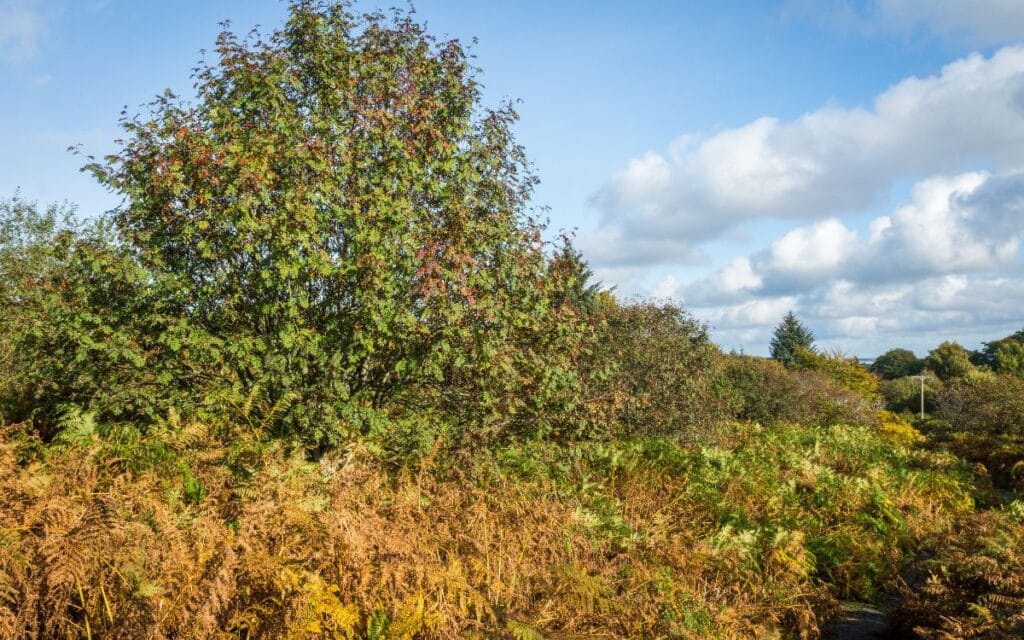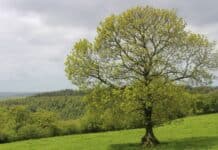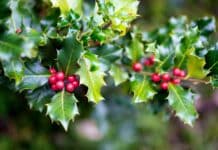Rowan trees are revered in British and Irish folklore as a magical guardian against evil forces. We take a look at its colourful history, which is interwoven with myths, medical uses and cultural significance.

The Rowan tree, often referred to as The Lady of the Mountain, is a small deciduous tree that thrives in mountainous regions but can also be found in the lowlands.
A member of the Rose family, the Rowan tree is often seen as a symbol of resilience and adaptability. Its leaves are long and slender, and it blossoms into clusters of creamy white flowers in May.
By autumn, it bears bright red berries that are much discussed in folklore and tradition, particularly in the UK and Ireland. The tree can live up to 200 years and grows no higher than 30-40 feet, making it a modest yet enduring part of our landscape.
The Rowan is a Sacred Tree in Scottish Tradition
In Scotland, the Rowan tree is considered one of the most sacred trees in folk tradition. The tree’s timber, bark, leaves and flowers are so revered that they are not allowed to be cut or used except for sacred purposes under special conditions. This level of respect highlights the Rowan’s deep-rooted significance in Scottish culture.
Saint Brigid Used Rowan For Her Spindle
The Rowan tree holds a special place in the hearts of both the Irish and Scots as it is associated with Saint Brigid, the Celtic patroness of arts, healing, and crafts. Spindles and spinning wheels in Scotland and Ireland were traditionally made from Rowan wood, signifying the tree’s importance in the countries’ daily life and spiritual practices.
Rowan Protects Stone Circles
Rowan trees planted near stone circles in Scotland were believed to have special powers. These trees were considered especially potent protectors against evil spirits. Scottish Fairies were said to hold their celebrations within these stone circles, shielded by the protective aura of the Rowan trees.
It Guards Against Evil
Rowan twigs were often placed above doorways and barns to protect against misfortune and evil spirits. The tree was considered sacred to Druids, who used its wood in rites of purification and to invoke spirits. The Druids also burnt Rowan on funeral pyres as a symbol of death and rebirth.
The Tree Inspired Bards
In ancient times, Bards considered the Rowan as the ‘Tree of Bards,’ believing it brought them the gift of inspiration. It is one of the nine sacred woods burnt in the Druids’ Beltane fire, a festival celebrating the beginning of summer.
Rowan Comes From The Norse Word ‘rune’
The word ‘Rowan’ is believed to be derived from the Norse word ‘rune,’ meaning charm or secret. In the Christian era, twigs have been used for protection against witches, sorcery and negative magic. Twigs tied in a cross with red thread are affixed to doors and barns, accompanied by the charm, “Rowan tree and red thread, will put witches to their speed”.
It’s Also Known As The Traveller’s Tree
Rowan is also known as the traveller’s or wayfarer’s tree because it was thought to prevent travellers from getting lost. Walking sticks made of Rowan are used to protect the user from the spirits of the woods, making it a popular choice for those journeying through unfamiliar territories.
There’s A Greek And Norse Connection
In Greek mythology, Rowan trees sprang up where the eagle shed feathers or blood in the quest to recover Hebe’s chalice. In Norse mythology, Thor was saved by clinging onto a Rowan tree when he was being swept away by a fast-flowing river in the Underworld. These myths underline the Rowan’s universal appeal and its role in various cultural narratives.
Rowan Is A Harbinger of Winter
A bountiful berry crop is traditionally seen as a sign of a hard winter to come. In Newfoundland, it predicts heavy snowfall, while in Sweden and Finland, a heavy crop and a hard winter with little snow are believed not to occur in the same year.
The Rowan Is Still Important In Modern Times
Today, Rowan berry jelly is still made in Scotland and is traditionally eaten with game. The wood is used for carving, tool handles, and even in modern Druidic practices. The berries are also used to make a variety of alcoholic drinks, including wine and spirits, and have medicinal properties like boosting the immune system and acting as a laxative.
The Rowan tree, with its folklore and myriad uses, continues to be a symbol of protection, inspiration, and resilience.
Have we missed customs or superstitions you know about Rowan Trees? Tell us in the comments section below!
Watch Rowan Tree Video







